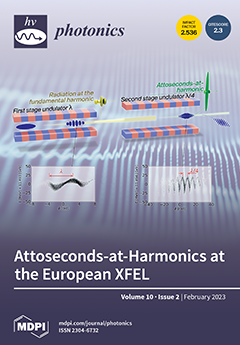We study the tight focus of generalized (hybrid) Poincaré beams. A conventional Poincaré beam is a coaxial superposition of two optical vortices, one with left circular polarization and a topological charge (TC) of
m, while the other has a right circular polarization
[...] Read more.
We study the tight focus of generalized (hybrid) Poincaré beams. A conventional Poincaré beam is a coaxial superposition of two optical vortices, one with left circular polarization and a topological charge (TC) of
m, while the other has a right circular polarization and a TC of −
m. The generalized Poincaré beams are also composed of two optical vortices, but their TCs are different, for instance,
p and
q. Here, we theoretically investigate the generalized Poincaré beams with the TCs
p =
m + 1 and
q = −
m in tight focus. In this case, both transverse components of the strength vector of the initial electric field have a topological charge of 1/2, and the beam itself is a cylindrical vector beam of fractional order
m + 1/2. Analytical expressions are derived for the components of the strength vectors of the electric and magnetic field at the focus as well as for the intensity distribution, the longitudinal component of the spin angular momentum (SAM), and for the components of the Poynting vector (energy flow density). We show that the intensity at the focus has 2
m − 1 local maxima residing evenly in a certain circle radius with the center on the optical axis. We also demonstrate that the radial spin and orbital Hall effects occur at the focus, i.e., the longitudinal SAM component has different signs in the circles of different radii, and the azimuthal component of the transverse Poynting vector also has different signs.
Full article





